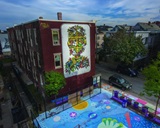One shared feeling? Nine months wasn’t enough. Getting to know each other personally and understanding how their organizations overlapped and dovetailed was just hitting a stride when the program was complete. Most of the connections will live on, but one takeaway was that more of a good thing would be better. Although the pandemic derailed many planned in-person gatherings it also tightened ties through its tribulations.
Jeena Hah, Director of Community Programs & Design at the Asian Community Development Corporation (Asian CDC), recalled, “After the first session, I felt we had found our organizational soulmates. It was so great that we could be convened. Each neighborhood in Boston has a cultural enclave, which brings so much richness, but the downside is that Boston is really segregated by race and class. So it was a treat and a gift to be able to cross boundaries and connect with people.” Hah shared some of her group’s work and philosophy in Chinatown, a neighborhood whose edges, she said, “are eroding like the seashore.” Asian CDC among other things is striving to “translate the ‘soft power’ of play and art and gardening into the ‘hard power’ of housing and business development and policy,” for example, using public art to create empathy and allow conversations that municipal public meetings don’t.
Organizational soulmate Central Square Business Improvement District is also using art to drive connections and anchor small business opportunities. His organization was formed with the goal of making Cambridge’s Central Square cleaner, safer and more welcoming. It battles challenges that other cities face—gentrification, the need for support of community institutions—and the particular challenge of capacity in a place “where corporations drive projects that idolize ‘innovation’ over stability.” Over the course of the PLN pilot, Executive Director Michael Monestime and his team transformed a city parking lot into a vibrant and multifunctional space for people. What became Starlight Square was in planning before COVID but accelerated, as Monestime put it, “trying to meet the scale of the crisis with the scale of an intervention like this.” What might have been expected to take 12 months was completed in 12 weeks. Scaffolding and scrim architected into faux buildings and temporary stages created space for summer programs, outdoor dining, public art, farmers markets and pop-up retail stalls for small-scale vendors. Monestime found the PLN invaluable: “The professional development, networking, being among peers where PLN had enabled action in learning and practice, and just being together, sharing ideas was fantastic…. My hope is that we [PLN cohort teams] become our own PLNs, bringing together a collective group, joining forces to bring changes we want to see in our communities. Take those learnings and model the behavior for others.”
The peer learning community and boundary-crossing were highlights for all, according to Sherman’s findings. While appreciating the input of experts, policymakers, funders, corporate types and others who came to PLN meetings, participants thought on the whole a better approach would be to flip the dynamic and have them present their perspectives and issues to the power brokers and experts. In Sherman’s assessment summary are several specific recommendations on how to improve upon and effectively run a similar program. However the how shakes out, the what is undeniable: “There is urgent need for a coordinated, equitable approach to community development.”


